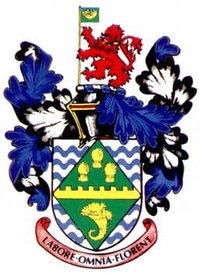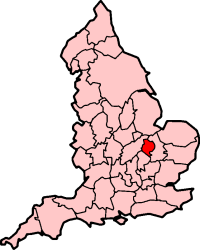Huntingdonshire
|
|
| Huntingdonshire District | |
|---|---|
| Missing image CambridgeshireHungtingdonshire.png Shown within Cambridgeshire | |
| Geography | |
| Status: | District |
| Region: | East of England |
| Admin. County: | Cambridgeshire |
| Area: - Total | Ranked 34th 912.47 km² |
| Admin. HQ: | Huntingdon |
| ONS code: | 12UE |
| Demographics | |
| Population: - Total (2003 est.) - Density | Ranked 96th 159,082 174 / km² |
| Ethnicity: | 97.2% White |
| Politics | |
 Huntingdonshire District Council http://www.huntsdc.gov.uk/ | |
| Leadership: | Leader & Cabinet |
| Executive: | Conservative |
| MPs: | Jonathan Djanogly, Shailesh Vara |
| Traditional County of Huntingdonshire | |

| |
Huntingdonshire (abbreviated Hunts) is a part of England around the town of Huntingdon, which is currently administered as a local government district of Cambridgeshire. It includes St Ives, Godmanchester, St Neots, and Ramsey.
It had previously been an administrative county in its own right, the 3rd smallest in England. This was merged with the Soke of Peterborough in 1965 to form the administrative county of Peterborough and Huntingdonshire. In 1974 it was annexed to Cambridgeshire as the Huntingdon district, which was renamed back to Huntingdonshire on October 1, 1984.
Huntingdonshire is also a traditional county. Many groups, such as the Association of British Counties (ABC) and their affiliates, state that most people from Huntingdonshire identify primarily with this county. Despite a local government reform in the 1990s which restored county councils for Rutland and Herefordshire, Huntingdonshire county council was not restored. There is an affiliate of the ABC that seeks to seek the restoration of a county council for Huntingdonshire.
The present district does not match the traditional county boundaries exactly - Fletton has been annexed to the City of Peterborough, Everton has been annexed to Bedfordshire and Swineshead is also currently administered by Bedfordshire council. It obtained Eaton Ford and Eaton Socon from Bedfordshire.
| Contents |
Towns and villages
Major Towns
Smaller towns and villages
- Alconbury, Alconbury Weston
- Bury, Bluntisham, Brampton, Cambridgeshire, Buckden
- Catworth,Colne, Covington
- Earith, Ellington, Elton, Everton
- Fletton, Fenstanton
- Glatton, Great Gransden, Great Paxton, Great Stukeley, Great Staughton
- Hartford, Hilton, Holme
- Keystone, Kimbolton, Kings Ripton
- Leighton Bromswold, Little Paxton, Little Stukeley
- Molesworth
- Offord Cluny, Offord D'Arcy, Old Weston, Orton Longville
- Sawtry, Somersham, Stilton, Stanground, Swineshead
- Upthorn, Upwood
- Warboys, Water Newton, Wooley
- Yelling
Famous people associated with Huntingdonshire
Detailed map
The following map shows the traditional county and its principal towns and villages. Contrast with the administrative district with which it shares its name. The river running from St. Neots to Earith is the Great Ouse.
History
Taken from the 1911 Encyclopaedia Britannica.
The earliest English settlers in the district were the Gyrwas, an East Anglian tribe, who early in the 6th century worked their way up the Ouse and the Cam as far as Huntingdon. After their conquest of East Anglia in the latter half of the 9th century, Huntingdon became an important seat of the Danes, and the Danish origin of the shire is borne out by an entry in the Saxon Chronicle referring to Huntingdon as a military centre to which the surrounding district owed allegiance, while the shire itself is mentioned in the Historia Eliensis in connection with events which took place before or shortly after the death of Edgar. About 915 Edward the Elder wrested the fen-country from the Danes, repairing and fortifying Huntingdon, and a few years later the district was included in the earldom of East Anglia. Religious foundations were established at Ramsey, Huntingdon and St Neots in the 10th century, and that of Ramsey accumulated vast wealth and influence, owning twenty-six manors in this county alone at the time of the Domesday Survey. In 1011 Huntingdonshire was again overrun by the Danes and in 1016 was attacked by Canute. A few years later the shire was included in the earldom of Thored (of the Middle Angles), but in 1051 it was detached from Mercia and formed part of the East Anglian earldom of Harold. Shortly before the Conquest, however, it was bestowed on Siward, as a reward for his part in Godwins overthrow, and became an outlying portion of the earldom of Northumberland, passing through Waltheof and Simon de St Liz to David of Scotland. After the separation of the earldom from the crown of Scotland during the Bruce and Balliol disputes, it was conferred in 1336 on William Clinton; in 1377 on Guichard d'Angle; in 1387 on John Floland; in 1471 on Thomas Grey, afterwards marquess of Dorset; and in 1529 on George, Baron Hastings, whose descendants hold it at the present day.
The Norman Conquest was followed by a general confiscation of estates, and only four or five thanes retained lands which they or their fathers had held in the time of Edward the Confessor. Large estates were held by the church, and the rest of the County for the most part formed outlying portions of the fiefs of William's Norman favourites, that of Count Eustace of Boulogne, the sheriff, of whose tyrannous exactions bitter complaints are recorded, being by far the most considerable. Kimbolton was fortified by Geoffrey de Mandeville and afterwards passed to the families of Bohun and Stafford.
The hundreds of Huntingdon were probably of very early origin, and that of Norman Cross is referred to in 963. The Domesday Survey, besides the four existing divisions of Norman Cross, Toseland, Hurstingstone and Leightonstone, which from their assessment appear to have been double hundreds, mentions an additional hundred of Kimbolton, since absorbed in Leightonstone, while Huntingdon is assessed separately at fifty hides. The boundaries of the county have scarcely changed since the time of the Domesday Survey, except that parts of the Bedfordshire parishes of Everton, Pertenhall and Keysoe and the Northamptonshire parish of Flargrave were then assessed under this county. Huntingdonshire was formerly in the diocese of Lincoln, but in 1837 was transferred to Ely. In 1291 it constituted an archdeaconry, comprising the deaneries of Huntingdon, St Ives, Yaxley and Leightonstone, and the divisions remained unchanged until the creation of the deanery of Kimbolton in 1879.
At the time of the Domesday Survey Huntingdonshire had an independent shrievalty, but from 1154 it was united with Cambridgeshire under one sheriff, until in 1637 the two Counties were separated for six years, after which they were reunited and have remained so to the present day. The shire-court was held at Huntingdon.
In 1174 Henry II captured and destroyed Huntingdon Castle. After signing the Great Charter John sent an army to ravage this county under William, earl of Salisbury, and Falkes de Breaut.
External links
- Huntingdonshire District Council (http://www.huntsdc.gov.uk/) - local government information
- Huntingdonshire (http://www.huntingdonshire.info/) - general informative
- The Huntingdonshire Society (http://www.rahbarnes.demon.co.uk/hunts/index.htm) - dedicated to the traditional county and campaigning for its reinstatement as an administrative entity
| Districts of England - East of England | 
|
|
Babergh | Basildon | Bedford | Braintree | Breckland | Brentwood | Broadland | Broxbourne | Cambridge | Castle Point | Chelmsford | Colchester | Dacorum | East Cambridgeshire | East Hertfordshire | Epping Forest | Fenland | Forest Heath | Great Yarmouth | Harlow | Hertsmere | Huntingdonshire | Ipswich | King's Lynn and West Norfolk | Luton | Maldon | Mid Bedfordshire | Mid Suffolk | North Hertfordshire | North Norfolk | Norwich | Peterborough | Rochford | St Albans | St Edmundsbury | South Bedfordshire | South Cambridgeshire | Southend-on-Sea | South Norfolk | Stevenage | Suffolk Coastal | Tendring | Three Rivers | Thurrock | Uttlesford | Watford | Waveney | Welwyn Hatfield | |
|
Administrative counties with multiple districts: Bedfordshire - Cambridgeshire - Essex - Hertfordshire - Norfolk - Suffolk |

